Here you will find pictures of my garb, and the stories that come with making it, and other things I make for the SCA. Unless otherwise specified, all pictures are credited to Windy Knoll Photography — my sister, whom you will find referred to as Olivia (mundane name) or Wynnie (not Winifred) (SCA name).
2015
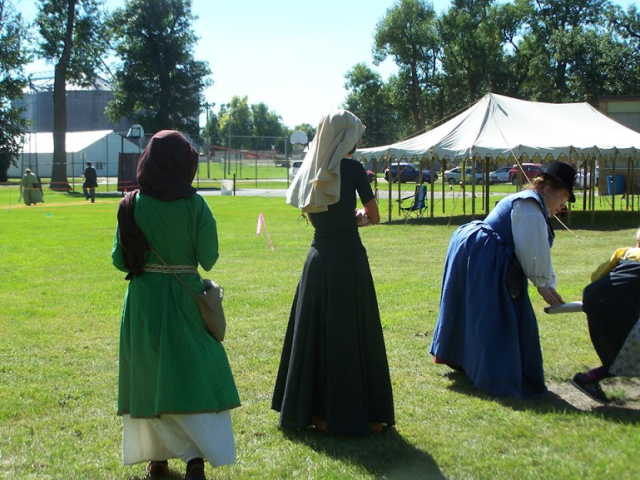
(Photo credit: Julia Samia May)
That’s my back on the left. This was my first garb, when I’d just gotten into the SCA. I was ambitious and hand-sewed the entire thing, which was about its only real virtue as a whole, as both the smock and the green dress are cotton, and I was new to historical research and mixed up the 10th century with the 1000s (which is really the 11th century) and didn’t discover that till afterwards, along with the handy bit of knowledge that the short overgown is not documentably period. Since the only distinction between men’s and women’s t-tunics is often the length, that green tunic is now loaner garb for any guy who can fit in it. The trim was a pain to put on but very nice once done.
It all boils down to the precept a lot of beginners overlook: Your First Garb Will Not Be Your Best. I won’t go into all the problems with everything here. It’s obvious from the picture that that outfit was a little wide for me, and you can kind of tell something’s up with the smock’s hem, if you look, and the veil is far from accurate for the late Anglo-Saxon era (but though it’s a dark colour I wasn’t too hot).
That smock is still my only smock, and perfectly fine. I followed a Basic T-Tunic pattern almost to the letter with it and the green one on top of it, so they’ve both got four gores (two at each side, one center front, one center back) and sleeve gussets, and the smock has pretty tight sleeves too. I accidentally made a slit in the smock for a keyhole neckline before realizing it was meant for the outer and not inner layer, so I sewed it up again, and that’s how I can tell which way is front.
I tablet-wove the belt myself (my first tablet-weaving) and it’s a bit wonky at one end because I finished in a hurry. I made the bag of fake leather, and still have it. It’s mainly just the too-short green tunic annoying me.
The friend of mine who introduced me to the SCA, Lady Christiana, is in the center of the picture. She hand-sewed her garb too (she’s about three hundred years later than me, creeping later). That was at Northshield’s Fall Coronation, 2015, when there was no such thing as a local group nearby.
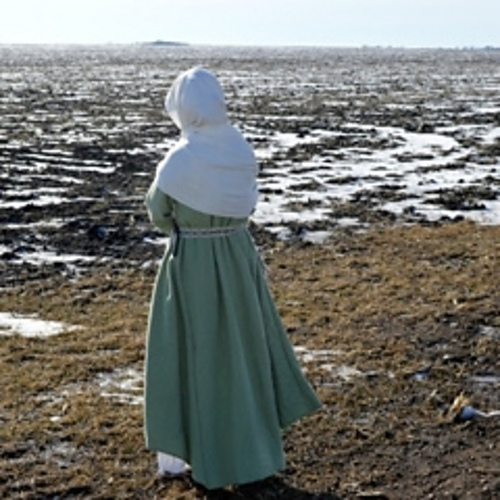
The green cyrtel, partly because the sleeves are a little too short, adapts nicely to early Anglo-Saxon as well. In the cover of Wind Age I’m wearing it with a tied veil and two necklaces, which is period for the seventh century. (And the veil is a dishtowel. Versatile things, aren’t they?)
The wool I made it of is herringbone weave (perfectly historically accurate for my era) with half the threads green and half undyed, so it’s not overwhelmingly green. Instead of front and back and side gores, I cut two very large gores and put them in the sides, eliminating the need for slits. However, thinking I wouldn’t waste fabric, I didn’t round off the bottoms, resulting in a wildly uneven hem and that learning from experience which is the beginning of wisdom, because now I know why the t-tunic pattern says “round off the bottoms of the gores”. The sleeves are plain, loose ones with no gussets — the gores came too high for that, but they don’t really need them. It does nothing for the incorrect idea that all medieval clothes were sacks, but it’s a comfortable sack and I like it, if it is a little warm for summer events.
2016
The blue cyrtel took me a little under two months to make. By hand, of course. Originally it was an old cotton sheet, cream-coloured, which I dyed with indigo (a very messy and occasionally frustrating process) and laid out on the grass to dry in the sun. It has only side gores, after the fashion of the green one, and Owen-Crocker’s cutting plan, in the back of Dress in Anglo-Saxon England, has only side gores also, so I’m in good company, but the sleeves are different. They’re fitted (perhaps a little too much) and boat-shaped, which places their period solidly at the end of the Anglo-Saxon era. For as small as the sleeves are, smaller than the ones on the woman fleeing the burning building in the Bayeux “Tapestry”, they have a definite knack for getting caught on a steering wheel (ask me how I know).
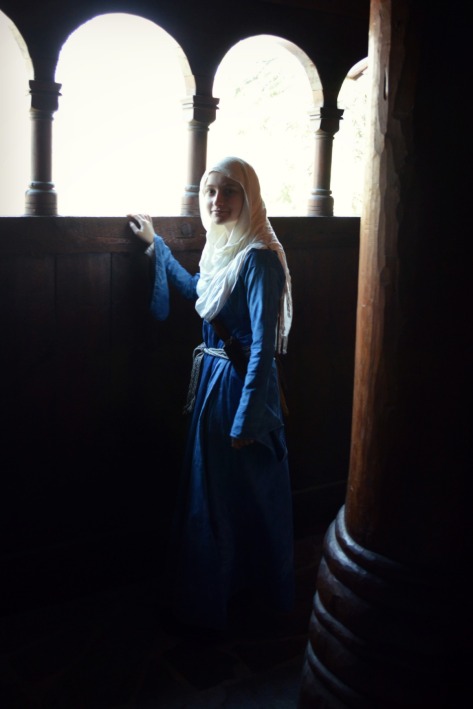
Spring Coronation, A. S. 51
At about the same time I made an enormous white half-circular veil from a white cotton sheet found at a thrift store. It’s three feet in radius, which turned out a bit big — it kept falling down past my shoulders and losing the lovely folds that make it look so much like period examples, so I only wore it that one time to Hadrian’s Feld. I could cut it down, but that would mean redoing the curved part of the hem, which is not a fun prospect.
At Hadrian’s Feld I started another belt in brown and light gray wool. The pattern for it was supposed to be diamonds, but wasn’t. In so far as it repeats itself it could be called a pattern, but it doesn’t really look like anything. But I keep it around in case I ever need a spare, or to lend to someone.
2017
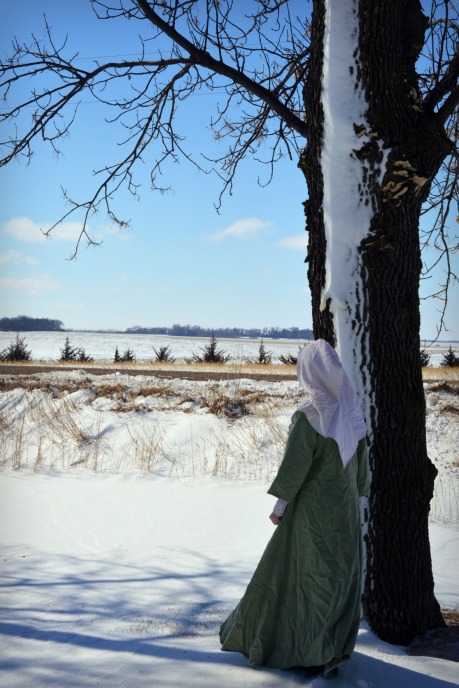
In June I re-did the green cyrtel’s gores, and you can read about the transformation, with pictures, here. It looks much better, and I don’t have lumps of fabric at the tops of the gores anymore.
2018
The veil I’m wearing in the above picture is the result of an experiment in making a hood-type veil, and you can read all about it, in detail and with pictures, here.
In February I got my Award of Arms at Lupercalia, an event I was sadly not able to go to (blizzards), and was originally not going to bother with a circlet. But then the local forming group was going to be recognized with full status as the Shire of Avonwood in May, at Crown Tournament, which we were hosting, and I decided it would be good to have one for that occasion.
The last time I’d borrowed tablet-weaving cards from Jenny, for my second belt, I thought I’d returned all of them, but four showed up in the car later. For most of the next year they came with me in my knitting bag and I perpetually forgot to return them. They came in handy on Tuesday afternoon of finals week, as I had a spare hour in which to sit down and make a circlet with some silver-gray wool (two-ply) from Knitpicks. No fancy pattern or anything, just four turns forward and four backward, when I could keep count.
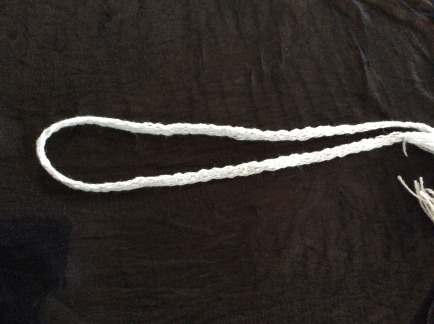
Just taken off the cards
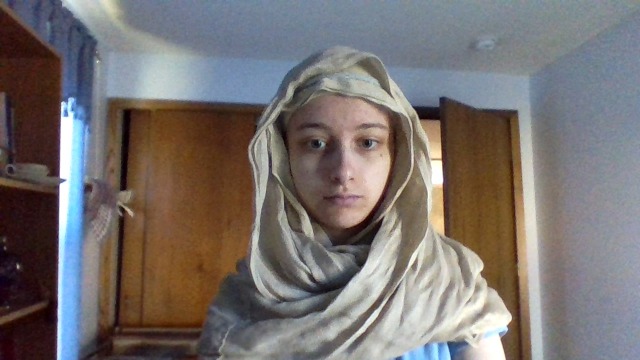
And with the veil, generally how I wore it at Crown, in a very low-quality computer picture because the usual photographer was probably racing to get done with hemming (or just being ornery, but you know).
Also during April I took the infinity scarf pictured above and turned it into a mobius. Before, as a simple tube, it had given a decently period look (always bearing in mind that we’re going off art, etc.), but it did get rather bulky in the chest because I had to twist it twice and all that had to go somewhere. With a mobius, the one necessary twist is in there already, and as you can kind of see in that picture (I’d just put it on, without pins, so things hadn’t settled down yet) it looks a lot like the pictures.
Also in April I started a little series of tutorials for Anglo-Saxon veils, which can be found below as I post them:
Miscellaneous:
The dark brown veil in the picture of my first garb, and the oblong white veil with fringe which you’ll see around here quite a bit oftener, are both pashminas of dubious fibre content, and I’ve forgotten where they came from. The tan or goldenish Mobius was a present from my sister, who found it in a thrift store. We suspect it’s rayon but have no way of knowing. But I didn’t make any of them.
I got a spindle for Christmas of (I think) 2016, and not till afterward did I do any research on period spindles. An historically-accurate one is still in my dreams, along with fur mittens, but it was easy to make a forked distaff out of buckthorn from our grove (a period plant as well), and I’ve been spinning since then. I bring it to events and sometimes spin at home.

Does the SCA hold a “thing” every year?
LikeLike
Practically every weekend, somewhere in the world, there’s an event. In Northshield there’s one almost every weekend. Whether it’s anywhere close to us is different, as NS is a big kingdom. Some events focus on fighting, others on the arts and sciences, some on teaching and classes. They range from a single day to two-week-long wars.
LikeLike
Interesting, how do know where and when events take place?
Well, to rephrase my question!
Does Northshield hold a “thing” similar to this one:
http://www.arild-hauge.com/elov.htm
How big, is Northshield?
LikeLike
Oh, that kind of “thing”. Not as such. Once in a while the board of directors will meet to pass laws, and of course a lot of events have fighting (not usually to decide justice), but the law-making itself isn’t a part of the events I’ve been to. The closest, I think, is when someone’s been banished in a royal Court. Or maybe when peerages have their meetings.
http://northshield.org/Events/ has a list of events coming up, so that’s how we know for our kingdom. For others, you’d probably look up their websites.
NS covers Minnesota, the Dakotas, Wisconsin, the upper peninsula of Michigan, and parts of Canada.
LikeLike
Didn’t someone say something along the lines: “for every answer, you have three more questions?
LikeLike